Fallschirmjäger (World War II)
| Fallschirmjäger | |
|---|---|
|
Fallschirmschützenabzeichen | |
| Active | 1935-1945 |
| Country |
|
| Branch | Luftwaffe |
| Type |
Paratrooper Infantry |
| Part of | Luftwaffe |
| Garrison/HQ | Berlin |
| Engagements | World War II |
The Fallschirmjäger were the paratrooper (German: Fallschirmjäger) branch of the German Luftwaffe before and during World War II. They were the first German paratroopers to be committed in large-scale airborne operations and came to be known as the "green devils" by the Allied forces they fought against.[1] Throughout World War II the Fallschirmjäger commander was Kurt Student.
Etymology
The word Fallschirmjäger is from the German Fallschirm "parachute" and Jäger "hunter", the elite light infantry of the Prussian army.
Pre-war history
During the interwar years the rapid development of aircraft and aviation technology drew the attention of imaginative military planners. The idea of inserting a large body of troops inside enemy territory was first proposed during World War I by commander of the U.S. Air Corps in France—Brigadier General Billy Mitchell.[2] However the Allied High Command was forced to abandon the idea as it was wholly unprepared for such an undertaking, both logistically and in materiel.[2] Among the first to recognize the potential of airborne forces were Italy and the Soviet Union.[3] The first effective means of supporting massed infantry airborne operations came with the development of the static-line parachute in Italy in the 1920s, whereby parachutes are attached to the inside of the aircraft and deployed automatically upon departure.[3] This technique allowed the jumps to occur at lower altitudes, limiting exposure to enemy fire, and providing a tighter drop zone grouping than individually deployed rip-cord type parachutes.[3]
The Soviets were the first to demonstrate the military possibilities of airborne infantry in the 1930s with a series of maneuvers held in 1935 and 1936.[3] Though somewhat crude (the Soviet paratroopers had to exit their slow-moving Tupolev TB-3 transporters through a hatch in the roof and then position themselves along the wings and jump together), the exercise managed to land 1,000 troops through air-drops followed by another 2,500 soldiers with heavy equipment delivered via airlandings. The gathered forces proceeded to carry out conventional infantry attacks with the support of heavy machine guns and light artillery.[4] Among the foreign observers present was Hermann Göring.[4]
Impressed, the ambitious Göring became personally committed to the creation of Germany's airborne arm in the 1930s.[5] As the Bavairan Prime Minister of the Interior, he ordered the formation of a specialist police unit in 1933, the Polizeiabteilung z.b.V. Wecke, devoted to protecting Nazi party officials. The organization of this unit was entrusted to Polizeimajor Walther Wecke of the Prussian Police Force, who had assembled a special detachment of 14 officers and 400 men within just two days.[5] On 17 July, the detachment was officially renamed Landespolizeigruppe Wecke z.b.V. (z.b.V. signifying zur besonderen Verwendung, "for special duties"), and was the first Landespolizeigruppe in Germany.[6] On 22 December 1933, the unit was again retitled, becoming the Landespolizeigruppe General Göring. The unit carried out conventional police duties for the next two years under the command of Göring's ministerial adjutant Friedrich Jakoby,[6] but it was Göring's intention to ultimately produce a unit that would match the Reichswehr.
In March–April 1935, Göring transformed the Landespolizei General Göring into Germany's first dedicated airborne regiment, giving it the military designation Regiment General Göring (RGG) on 1 April 1935 (after Hitler introduced conscription on 16 March 1935).[6] The unit was incorporated into the newly formed Luftwaffe on October 1 of the same year and training commenced at Altengrabow. Göring also ordered that a group of volunteers be drawn for parachute training. These volunteers would form a core Fallschirmschützen Bataillon ("parachute soldiers battalion"), a cadre for future Fallschirmtruppe ("parachute troops").[6] In January 1936, 600 men and officers formed the 1st Jäger Battalion/RGG, commanded by Bruno Bräuer, and the 15th Engineer Company/RGG and were transferred to training area Döberitz for jump training while the rest of the regiment was sent to Altengrabow.[7] Germany's parachute arm was officially inaugurated on 29 January 1936[8] with an Order of the Day calling for recruits for parachute training at the Stendal Parachute Training School located 96 km (60 mi) west of Berlin. The school was activated several months after the first parachute units were established in January 1936 and was open to active and reserve Luftwaffe personnel. NCOs, officers and other ranks of the Luftwaffe were required to successfully complete six jumps in order to receive the Luftwaffe Parachutist's Badge (instituted on 5 November 1936).[8]
World War II
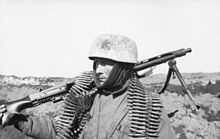
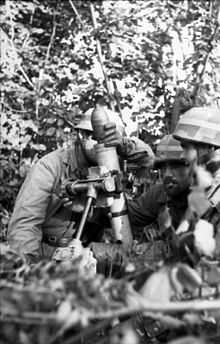
During World War II, the Luftwaffe raised a variety of airborne light infantry (Fallschirmjäger) units. Unlike the United Kingdom, the British Commonwealth, and the United States, the German paratroopers were part of the Luftwaffe rather than the Heer (German Army). Starting from a small collection of Fallschirmjäger battalions at the beginning of the war, the Luftwaffe built up a division-sized unit of three Fallschirmjäger regiments plus supporting arms and air assets, known as the 7th Flieger Division (7th Air Division).
Fallschirmjäger units made the first airborne invasion when invading Denmark on the 9 April 1940. In the early morning hours of Operation Weserübung, they attacked and took control of Aalborg Airport which played a key role as a refueling station for the Luftwaffe in the subsequent invasion of Norway. In the same assault the bridges around Aalborg were taken. Other airborne attacks during the German invasion of Denmark were also carried out, including one on a fort on the island Masnedø, protecting the important Storstrøm Bridge.
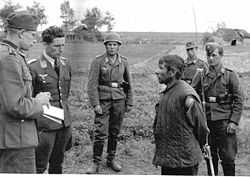
The first opposed airborne attacks occurred during the Norwegian Campaign, first during the initial invasion when Fallschirmjäger captured the defended air base of Sola, near Stavanger. The Fallschirmjäger also had their first defeat in Norway, when a company was dropped on the village and railroad junction of Dombås on 14 April 1940 and was destroyed by the Norwegian Army in a five-day battle.[9]
Later in the war, the 7th Air Division's Fallschirmjäger assets were re-organised and used as the core of a new series of elite Luftwaffe Infantry divisions, numbered in a series beginning with the 1st Fallschirmjäger Division. These formations were organized and equipped as motorized infantry divisions, and often played a "fire brigade" role on the western front. Their constituents were often encountered on the battlefield as ad hoc battle groups (Kampfgruppen) detached from a division or organized from miscellaneous available assets. In accord with standard German practice, these were called by their commander's name, such as Group Erdmann in France and the Ramcke Parachute Brigade in North Africa.
After mid-1944, Fallschirmjäger were no longer trained as paratroops due to the realities of the strategic situation, but retained the Fallschirmjäger honorific. Near the end of the war, the series of new Fallschirmjäger divisions extended to more than 12, with a concomitant reduction in quality in the higher-numbered units of the series. Among these divisions was the 9th Fallschirmjäger Division, which was the last parachute division to be raised by Germany during World War II. The division was destroyed during the Battle of Berlin in April 1945. (These divisions should not be confused with the Luftwaffe Field Divisions, a poorly organised and managed series of light infantry divisions raised from excess Luftwaffe personnel early in the war.)
Over 54,449 paratroops were killed in action and over 8,000 are still listed as missing in action.
Fallschirmjäger were awarded a total of 134 Knight's Crosses between 1940 and 1945. Twenty-four KC were awarded in the west and 27 were awarded after Crete. Out of the 134 KC, 15 were with oak leaves, five with oak leaves and swords, and one with oak leaves, swords and diamonds.
Operations
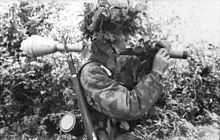
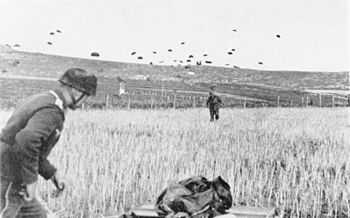

Fallschirmjäger participated in many of the famous battles of World War II and in many theatres. As elite troops they were frequently deployed at the vanguard of attacks and as the bulwark of a defence. They would see action in the Norway and Denmark campaign and in Belgium, the Netherlands and France in 1940. Major actions in the Balkans Campaign, Crete, Italy, and on both the Eastern Front and later the Western Front would follow.
Notable operations
The skillful airborne seizure of Fort Eben-Emael permitted the early capture of Belgium and, alongside successful operations in the Netherlands, was crucial for the speed of the German victories in 1940. The major airdrops in Norway and Denmark in May 1940 was also vital to the success of the campaign there.
The Battle of Crete in 1941 saw large scale airdrops in which the entire 7th Air Division was deployed with the 5th Mountain Division as the follow-up. Crete was captured, along with many enemy troops and weapons, but the high casualties suffered by the Fallschirmjäger as they parachuted in convinced Hitler that such mass airdrops were no longer feasible. Unknown to the Germans, the element of surprise had been lost before the drops started due to Polish cracking of the Enigma cipher.
Fallschirmjäger also played a key role defending positions in France against much larger forces during the Battle of Normandy in 1944. The Battle of Carentan saw Fallschirmjäger fight American paratroopers in a short but intense engagement. The defense of Fortress Brest, at which the core of the defending forces were Fallschirmjäger including the commander Generalleutnant Ramcke, delayed the American advance through 99 days of combat.
The Battle of Monte Cassino was one of the finest displays of the courage, tenacity and skill that the Fallschirmjäger became known for. The 1st Fallschirmjäger Division held the ground near the Monastery of Monte Cassino but did not occupy the building itself. The historical significance of the Benedictine monastery caused the German commander-in-chief in Italy, Field Marshal Albert Kesselring, to order German units not to include the monastery in German defensive positions and informed the Allies accordingly.[10][11] The Allied high command refused to believe that the German forces would not use such a valuable position in their defences and orders were duly given for the 1500 year old building to be bombed to rubble. After the bombing, the Germans moved into positions among the bricks, remnants of walls and still intact cellars which provided excellent protection for the troops. This enabled the Fallschirmjäger to hold out for months against repeated assaults and heavy bombardment. Here they gained the nickname of the "Green Devils" from the Allied forces for their distinctive ¾-length splinter pattern camouflage jackets and their tenacious defence of the ruined town and monastery on the mountain above against far superior numbers. Inflicting huge losses on the allied forces, they ultimately retreated from their positions only to avoid being outflanked. After their withdrawal, Polish, Indian, Senegalese, Moroccan and Brazilian forces finally occupied the ruins of the monastery.
Also in Italy, a smaller but equally fierce battle occurred as the 3rd battalion, 3rd Regt, 1st Fallschirmjäger Division fought against elements of the 1st Canadian Infantry Division and the 1st Canadian Armoured Brigade during the Battle of Ortona, Italy, from December 20, 1943 to December 28, 1943. The battle was dubbed "Little Stalingrad"[12] for the deadliness of its close-quarters combat.
Uniforms and equipment
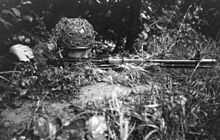
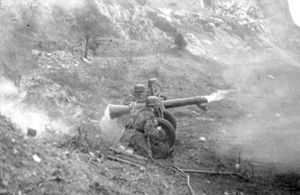
Fallschirmjäger were awarded the Fallschirmschützenabzeichen, a paratrooper insignia featuring a diving gold eagle gripping a swastika.
A special version of the German armed forces' (Wehrmacht's) modernized steel helmet (Stahlhelm), the M1935, called the Fallschirmhelm, was designed and issued to Fallschirmjäger units. It did away with the projecting visor and deep, flared rim of the standard-issue helmet, and added further improvements. The modified shell incorporated a completely different and more substantial leather liner and chinstrap design that provided far more protection for German airborne troops; this model was known as the "M1938".
The style of parachute harness used by the Fallschirmjäger, however, is generally considered inferior to those used by the war's British and American paratroopers. Unlike the British and American models, which connected the chute at each shoulder, the German design connected the parachute to the trooper's body via a single strap in the center of the back, an Irving-type harness. Paratroopers had to throw themselves forward out of the aeroplane, and in the resulting face-down position when the chute opened, control was nearly impossible. To remove their parachute harness, required the paratrooper to stand stationary upright for up to 80 seconds. The necessity of landing on knees and elbows reduced the amount of equipment the trooper could carry and, even with pads, significantly increased the chance of injury. As a result, they jumped armed only with a holstered pistol and a small "gravity knife". Rifles and other weapons were dropped in separate containers and, until these were recovered, the soldiers were relatively poorly armed (by comparison, Allied paratroopers were dropped armed with rifles or submachine guns). The Japanese copied the German system.
After the Crete invasion, these faults were rectified, with the parachute harness modified to allow it to be released while prone in under 10 seconds; and the paratroopers jumped while armed with personal automatic weapons.[13]
Fallschirmjäger units were usually very well equipped; they had access to the best weapons of the German military. They were among the first combat units to use assault rifles and recoilless weapons in combat. Fallschirmjäger also readily employed the best of several foreign-made small arms, including the Italian Beretta Modello 38 9 mm submachine gun,[14] and the FN Browning P-35 9 mm pistol.
A universal weapon was developed specifically for the paratroopers that could replace rifles, submachine guns and light machine guns but was also light enough to be carried during a jump. These efforts resulted in the FG 42 automatic rifle which combined the firepower of a machine gun with the lightweight handling characteristics of a standard infantry rifle. The FG 42 was built and deployed in small numbers from 1943 until the end of the war. Though an extremely advanced weapon,[15][16] the design had some drawbacks. The lightweight frame was subject to considerable muzzle rise when in automatic fire and had to be fired prone to guarantee accuracy. This meant that the FG 42 was not entirely compatible with the more universal role it was supposed to play, as both a light machine gun and assault rifle. The FG 42's advanced design also meant that the weapon could not be mass-produced in a cost efficient manner, and use of certain precious metals in the gun's construction placed it in competition with other wartime projects for increasingly scarce resources.
The Parachutist's "Ten Commandments"

A revealing document captured from a German paratrooper who was taken prisoner in Greece reveals much of the Fallschirmjägers elite attitude. Titled the Ten Commandments[17][18] it listed the following instructions:
- You are the chosen ones of the German Army. You shall seek combat and train yourselves to endure any manner of test. To you, battle shall be the fulfillment.
- Cultivate true comradeship, for by the aid of your comrades you will conquer or die.
- Beware of talking. Be not corruptible. Men act while women chatter. Chatter may bring you to the grave.
- Be calm and prudent, strong and resolute. Valour and enthusiasm of an offensive spirit will cause you to prevail in the attack.
- The most precious thing in the presence of the foe is ammunition. He who shoots uselessly, merely to comfort himself, is a man of straw who merits not the title of Fallschirmjäger.
- Never surrender; to you death or victory must be a point of honour.
- You can triumph only if your weapons are good. See to it that you submit yourself to this law - first thy weapon, then thyself.
- You must grasp the full purpose of every enterprise, so that if your leader is killed you can fulfill it.
- Against an open foe, fight with chivalry, but to a guerrilla, extend no quarter.
- Keep your eyes wide open. Tune yourself to the utmost pitch. Be nimble as a greyhound, tough as leather, hard as Krupp steel. You shall be the German warrior incarnate.
Luftwaffe parachute units
Army and corps
- Fallschirmjägerarmee
- 1. Fallschirmarmee
- Fallschirmjägerkorps
- I. Fallschirmkorps
 Murder of Greek civilians in Kondomari by Fallschirmjäger in 1941.
Murder of Greek civilians in Kondomari by Fallschirmjäger in 1941. - II. Fallschirmkorps
- I. Fallschirmkorps
Divisions
- 1. Fallschirmjägerdivision, Fallschirmjägerregimenter (FJR).1, FJR.3, FJR.4, 1st FJAR
- (as 7th Flieger Division with FJR.1, FJR.2, FJR.3, FJR.4, FJR.5)
- 2. Fallschirmjägerdivision, FJR.2, FJR.6, FJR.7, FJR.23, 2nd FJAR
- 3. Fallschirmjägerdivision, FJR.5, FJR.8, FJR.9
- 4. Fallschirmjägerdivision, (formed from the Italian 184th Nembo Parachute Division (Italy); destroyed at Anzio.[19]) FJR.10, FJR.11, FJR.12
- 5. Fallschirmjägerdivision, (the last fully trained parachute unit) FJR.13, FJR.14, FJR.15, 5th FJAR
- 6. Fallschirmjägerdivision, FJR.16, FJR.17, FJR.18
- 7. Fallschirmjägerdivision, (only some of its units were parachute trained) FJR.19, FJR.20, FJR.21
- (as Fallschirm-Jäger-Division Erdmann: FJR.Menzel, Grossmehl, Greve, Hübner, Laytved-Hardegg)
- 8. Fallschirmjägerdivision, FJR.22, FJR.24, FJR.32
- 9. Fallschirmjägerdivision, FJR.25, FJR.26, FJR.27
- 10. Fallschirmjägerdivision, FJR.28, FJR.29, FJR.30, 10th FJAR
- 11. Fallschirmjägerdivision, FJR.37, FJR.38, FJR.39, 11th FJAR
- 20. Fallschirmjägerdivision, (never finished forming) FJR.58, FJR.59, FJR.60, 20th FJAR
- 21. Fallschirmjägerdivision, (never finished forming) FJR.61, FJR.62, FJR.63 formed from Sturm-Brigade Gericke and Fallschirmjäger-Ausbildungs-und-Ersatz-Division
- Fallschirmjäger-Ausbildungs-und-Ersatz-Division, formed basis for 20. Fallschirmjägerdivision and 21. Fallschirmjägerdivision
Regiments and brigades
- Brigades
- Ramcke Parachute Brigade aka Luftwaffen-Jäger-Brigade 1
- Luftlande-Sturm-Regiment with Battalions I, II, III, and IV.
- Barenthin Regiment- formed from drafts from other units
- Fallschirmjäger-Sturmgeschütz-Brigaden - Assault gun Units equipped with StuG III's and StuG IV's
- Fallschirmjäger-Sturmgeschütz-Brigade XI - StuG III's only
- Fallschirmjäger-Sturmgeschütz-Brigade XII
- Regiments
- Heerestruppe (Army Troops) FJR.6, FJR.31, FJR. z.b.V., FJR. Schellmann, FJR. Jungwirth
- Fallschirmjäger-Regiment Hübner aka Fallschirmjäger Regiment (FJR) 24 and subordinated to the 8. Fallschirmjäger Division.
Other parachute units
Waffen-SS
Army
- Schweres-Fallschirm-Infanterie Battalion
- Brandenburger Regiment aka Panzergrenadier-Division Brandenburg
- Fallschirm-Battalion Brandenburg
- 22nd Air Landing Division
- 91st Air Landing Division
Luftwaffe
Para-trained commandos of II/KG 200 (also known as the 3rd Staffel of Kampfgeschwader 200), were a Luftwaffe special forces unit who were para-trained commandos. II./KG 200 remain a mostly unheard of arm of Germany's World War II parachute forces due to the nature of their role and were listed on II./KG 200's ORBAT as the 3rd Staffel.
In popular culture
In the Jack Higgins book and movie adaption The Eagle Has Landed, a group of Fallschirmjäger are featured in a fictional operation where they covertly land in England in an attempt to kidnap Winston Churchill. Within the book and movie, the Fallschirmjäger are portrayed as professional soldiers and heroic as one sacrifices his life to rescue a British girl, and the commanding officer throws his career away in an attempt to save a Jewish girl.
In the video game Turning Point: Fall of Liberty, the main attack force in the initial Nazi invasion of New York city, are Fallschirmjäger troops. They are first seen when they land on the skyscraper the player character is working on.
In the massively multiplayer online game World War II Online, it is possible for Axis players to play as Fallschirmjäger. Parachute drops are possible.
In Call of Duty 3 the Fallschirmjäger appear as the main enemies in the level "The Island".
In World War II real-time strategy game Company of Heroes, Fallschirmjäger are portrayed as stealthy units, able to hide in cover and infiltrate the battlefield unseen, and as extremely lethal to enemy infantry when equipped with their FG42.
In the strategy game R.U.S.E they can be researched and used when playing as Germany. They are the best paratroopers in game, given the moniker of elite infantry, and can defeat any other infantry unit (except other elite infantry) in battle.
In the World War II first-person shooters Brothers in Arms: Road to Hill 30 and Brothers in Arms: Earned in Blood, a number of Fallschirmjäger units meet the 101st Airborne in combat. Only the Waffen-SS are comparable to them as the most skilled enemy soldiers in the game.
In L.J Adlington's novel 'Burning Mountain', main characters Erich Bergen and Peter Shäfer are both members of the Fallschirmjäger.
Notable World War II German paratroopers
- Max Schmeling, boxing heavyweight champion of the world 1930-32, remembered for being defeated by Joe Louis in 1938 whom he had previously beaten.
- Bert Trautmann, taken prisoner of war by the British as one of only 90 survivors of his 1000 man regiment, he remained in Britain and became a professional footballer who played for Manchester City from 1949 to 1964
- Major-General Bruno Bräuer, was the first German paratrooper to jump from a plane in 1936 and later was military commander of occupied Crete.
- General der Fallschirmtruppe Eugen Meindl, survived a chest wound that removed him as first commander of the invasion of Crete and was one of 160 recipients of the Knights Cross of the Iron Cross with Oak Leaves and Swords.
- General der Fallschirmtruppe Hermann-Bernhard Ramcke, a pre-World War I cabin boy who rose through the ranks as a naval gunnery chief and then marine in the trenches of Flanders, fought the Bolsheviks as an infantryman, and earned his paratroopers badge at age 51, serving on every German front during World War II. One of only 27 recipients of the Knights Cross of the Iron Cross with Oak Leaves and Swords and Diamonds.
- Generaloberst Kurt Student, was the commander of German paratroopers throughout World War II and the chief architect of their airborne assault strategies.
See also
References
- ↑ Green Devils: German Paratroopers 1939-1945 By Jean-Yves Nasse, W. Muhlberger, G. Schubert, Jean-Pierre Villaume,
- ↑ 2.0 2.1 Ailsby, Christopher: Hitler's Sky Warriors: German Paratroopers in Action, 1939-1945, page 12. Spellmount Limited, 2000.
- ↑ 3.0 3.1 3.2 3.3 Ailsby, 16
- ↑ 4.0 4.1 Ailsby, 18
- ↑ 5.0 5.1 Ailsby, 21
- ↑ 6.0 6.1 6.2 6.3 Ailsby, 22
- ↑ Ailsby, 23
- ↑ 8.0 8.1 Ailsby, 26
- ↑ Bjørn Jervaas: The Fallschirmjäger Battle at Dombaas (English)
- ↑ Time, The Bombing of Monte Cassino
- ↑ [Monte Cassinoby David Hapgood (Author), David Richardson]
- ↑ Ortona By Mark Zuehlke # Publisher: Douglas & McIntyre (May 2004)Language EnglishISBN 1550545574 ISBN 978-1-55054-557-9
- ↑ Comparison of the Invasion of Crete and the Proposed Invasion of Malta, by S Kavanaugh, 1994 http://www.dtic.mil/cgi-bin/GetTRDoc?Location=U2&doc=GetTRDoc.pdf&AD=ADA452022
- ↑ Quarrie, Bruce, Fallschirmjäger: German Paratrooper, 1935-45, Osprey Publishing (2001), ISBN 1-84176-326-8, ISBN 978-1-84176-326-2, p. 59
- ↑ Senich, Peter: The German Assault Rifle: 1935–1945, page 239. Paladin Press, 1987.
- ↑ Miller, David: Fighting Men of World War II: Axis Forces : Uniforms, Equipment and Weapons, page 104. Stackpole Books, 2007.
- ↑ The Ten Commandments of the German Fallschirmjäger
- ↑ U.S. World War II intelligence report on Fallschirmjäger
- ↑ Battaglione Paracadutisti Nembo
Bibliography
- Ailsby, Christopher (2000). Hitler's Sky Warriors: German Paratroopers in Action, 1939-1945. Staplehurst, UK: Spellmount Limited. ISBN 1-86227-109-7.
External links
- 5thfjr.com 5th FJR - World War II Reenactment Unit
- U.S. World War II intelligence report on Fallschirmjäger
- Weapons and equipment of the Fallschirmjäger
- hist2004 Fallschirmjäger on the Eastern Front 1941-1945 24 May 2004
- GermanParatrooper.org FJR 5 - World War II Reenactment Unit.
- The Frontline Association World War II re-enactment group, mainly portraying Fallschirmjäger Regiment 9
- World War II uniform of the fallschirmjäger
- Fallschirmjäger 1 Parachute Division Information on 1st Fallschirmjäger Division
- Green Devils of Carentan FJR 6 - World War II Fallschirmjäger Reenactment
| Wikimedia Commons has media related to Fallschirmjäger (Wehrmacht). |
